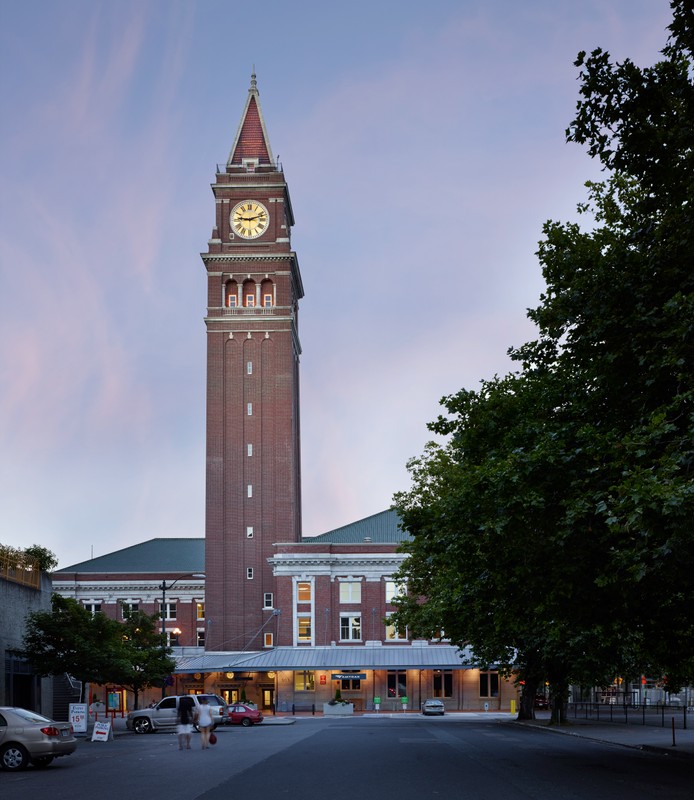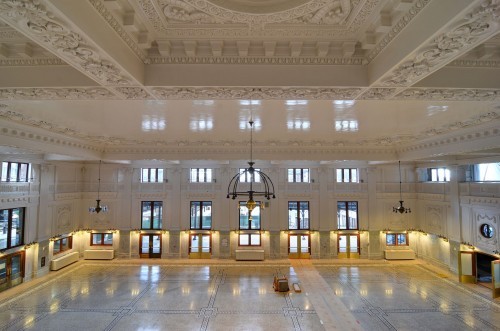King Street Station
Introduction
Author-Uploaded Audio
Listen to a narration of this entry's description by Robert Catherman.
Text-to-speech Audio
Let’s begin our tour at Seattle’s historic King Street Station.
Completed in 1906, this elegant station originally served both the Great Northern Railway and the Northern Pacific Railway. Designed by the architectural firm Reed and Stem, the building features brick, stone, and terra cotta detailing. Its most striking feature—the four-sided clock tower—was inspired by the campanile in Venice’s Piazza San Marco.
Today, King Street Station is part of an intermodal transportation hub, serving Amtrak trains and Sound Transit commuter rail, with additional commercial space available for lease. The station was recognized for its historical significance when it was added to the National Register of Historic Places in 1973.
Images
King Street Station (image from the City of Seattle)

The restored main waiting room (image from Seattle Transit Blog)

Backstory and Context
Author-Uploaded Audio
Listen to a narration of this entry's description by Robert Catherman.
Text-to-speech Audio
As the Northern Pacific Railroad’s transcontinental line neared completion in the 1880s, it became clear that choosing Tacoma—rather than Seattle—as its western terminus was a misstep. Seattle, recognizing the missed opportunity, quickly responded by building its own branch lines. By the 1890s, much of Northern Pacific’s business had shifted to Seattle.
In 1887, Railroad Avenue (now Alaskan Way) opened along the Elliott Bay shoreline. However, its early years were disrupted by Seattle’s Great Fire of 1889. Meanwhile, James J. Hill, a Canadian-American entrepreneur and owner of the Great Northern Railway, extended his line to Seattle in 1893, making him the first to build a transcontinental railroad without government assistance.
That same year, the Panic of 1893 led to Northern Pacific’s bankruptcy. The Great Northern and Northern Pacific railroads began sharing a modest wooden terminal—Union Depot—on Railroad Avenue. In 1896, Hill acquired controlling interest in Northern Pacific, and by 1902, plans were underway for a grand new station built on filled tide flats away from the waterfront.
The prominent St. Paul architectural firm Reed & Stem was commissioned in 1903 to design the new terminal. When King Street Station opened in May 1906, its L-shaped design and four-faced clock tower—then the tallest structure in Seattle—made a striking impression. The station’s interior featured ornamental plaster ceilings, chandeliers, white marble columns, terrazzo floors, and a compass mosaic at the entrance, capturing the glamour of early 20th-century rail travel.
As the popularity of air travel grew in the mid-20th century, King Street Station declined. Poorly conceived modernization efforts covered its ornate features with acoustical tiles, laminate, and fluorescent lighting, while windows were boarded and the grand waiting room was divided up.
By the 1990s, the building was owned by Burlington Northern Santa Fe (BNSF), with Amtrak and Sound Transit as tenants. In 2008, the City of Seattle purchased the station and began a major restoration. Original features hidden since the 1960s—including decorative plaster, mosaic floors, and arched windows—were carefully uncovered and restored. The clock tower was repaired, and new train platforms were added.
Although King Street Station was added to the National Register of Historic Places in 1973, its main waiting room didn’t reopen in restored form until April 2013, once again reflecting the elegance and architectural beauty of its early years.
Sources
Amtrak. "Seattle, WA (SEA)." Amtrak Presents: Great American Stations. Accessed August 30, 2016. http://www.greatamericanstations.com/Stations/SEA
Caldbick, John. "King Street Station (Seattle)." History Link: The Free Online Encyclopedia of Washington State History. October 17, 2015. Accessed August 30, 2016. http://www.historylink.org/index.cfm
Corley, Margaret A. "King Street Station." National Parks Service, National Register of Historic Places. July, 1969. Accessed August 1, 2016. http://focus.nps.gov/GetAsset?assetID=60e5a559-67e1-458d-87b3-b7e637deb94a.
